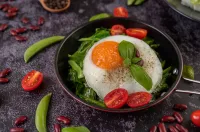The Ideal Eggplant
Freshly picked eggplants taste best and are also the most ideal for cooking. Always aim to pick young eggplants instead of old, overripe ones (since the latter are the ones more likely to have a bitter taste). Look for firm eggplants with glossy, bright skin. If it is squishy and the skin gives with just a little pressure, then better leave it on the shelf.
To Peel or Not to Peel, That is the Question
Do you need to peel eggplants? The answer to this is entirely up to you. In general, eggplant skins are very much edible and can be left on (especially so if the eggplant is still young and on the small side). However, larger and older eggplants can be peeled with their flesh cubed or sliced as needed. If you're going to roast the eggplant, you can opt to leave the skin on during the roasting process. Once it has been roasted, you'll find the skin easier to peel off than when it was uncooked.
Is Salt a Requirement?
There's a whole lot of debate regarding the need to salt eggplants before they can be cooked. Applying salt to an eggplant draws the moisture out of it and firms it up. It also neutralizes the bitterness if you are using an older eggplant.
However, as mentioned, bitter eggplants are a rarity. Chinese and Japanese eggplant varieties rarely need salting. However, if you find that you like the taste of eggplants that were salted beforehand, then don't let anyone stop you from getting that salt shaker.
Frying Eggplants
Sadly, eggplants do soak up a lot of oil when you fry them. There are ways to remedy this, of course. First slice up some eggplant, then brush one side with oil. Fry it on a skillet oil-side down and take care not to crowd the eggplant slices. Once that side has been cooked, brush the un-oiled side with oil, and then turn it. Fry until the slices are nice and brown. Doing it this way minimizes the chance of the oil soaking through the eggplant slices.
Roasting Eggplants
You can also cook eggplants in the oven. Simply put them in an oven at 400F with the skin off. Roast until the flesh is softened and the skin turned a dark color. This could take 20 minutes or more depending on the size of your eggplant.
Once the eggplant has softened, the skin can easily be peeled off. The roasting method is best if you want to make dips or spreads out of the eggplant flesh.
Baking Eggplants
You can cut eggplants into slices or strips. Then brush the pieces with olive oil and bake in a 350F oven. Flip them over once, and then return them to the oven. The eggplant is ready once they turn brown. Optionally, you can also dredge them in egg and then breadcrumbs before baking.
Spacing Matters
Do you want firmer or crispier eggplant slices? Then give them enough space on the skillet or on the baking pan. The reverse is also true - if you want softer slices of eggplant, you can place them closer together.

 How to Cook Cucumbers
How to Cook Cucumbers How to Cook Kale
How to Cook Kale



